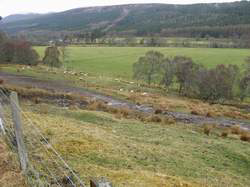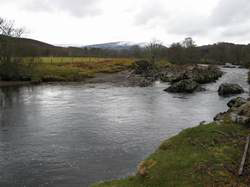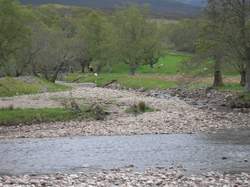Abandoned Communities ..... Strathcarron
In 1854, however, the decision was taken to clear Greenyard. At that time 24 families were still living on the estate, which extended along the south bank of the Carron a few miles east of Glencalvie. The evictions were managed, not by Gillanders, but by the tacksman of Greenyard, Alexander Munro. Munro had assured the people that there were no plans to evict them, but on 7 March he authorised a Sheriff-officer, William MacPherson and his witness, to deliver summonses of removal.
The people of Greenyard got wind of Munro’s action, and they had organised an effective early warning system. As MacPherson approached Braelangwell, on the north bank of the river, he was met by a group of women and some boys. The women demanded that MacPherson should produce a mandate from Munro authorising the delivery of the summonses. As he could not do so, the women held him, searched his pockets, took the summonses from him, and burnt them. All this seems to have happened in an amicable way, as immediately afterwards one or two local men appeared and invited MacPherson and his colleague to have a drink with them. All the men went down to Ardgay and enjoyed refreshments and some spirits at the inn.
A fortnight later there was a bizarre incident in which three other men pretended to be officers of the sheriff. They overheard some women in a public house discussing the issue of the evictions at Greenyard, and set off up the Carron valley intent on “having some fun” with the women of Greenyard. Again the early warning system came into effect, and the men found themselves confronted by several women. They could not satisfy the demands to show a mandate from Mr Munro, and started to become alarmed as the women surrounded them. One of the men, a “long, ugly-looking fellow with huge moustaches”, admitted that they were bogus and begged to be released. At first he was not believed by the women, who continued to demand sight of their papers. One of the men drew a loaded pistol. A young lad who had been watching responded by pulling out an old rusty pistol used for frightening crows, and the man was persuaded to put his pistol away. In the end the women accepted that the men were imposters, and let them go.
The removal summonses were eventually served on Friday 31 March. My summary of the events of that day will be drawn from the account given by Donald Ross, a Glasgow lawyer who published a pamphlet called The Massacre of the Rosses. I should, however, mention that there are two other published accounts, one written on the day by Mr Taylor, the Sheriff-substitute, the other a report in the Inverness Courier. Both of these accounts confirm that considerable violence was used by the official group and some serious injuries suffered by those at the receiving end, but they tend to condone the official action and do not report the extent of injuries to individuals as described by Donald Ross.
The two alternative accounts are mentioned in John Prebble’s book, The Highland Clearances, and are summarised in Eric Richards, The Highland Clearances, Birlinn Ltd 2000, chapter 16.
The group with the responsibility of delivering the summonses comprised about 40 men. Most of them were police constables, but the group was led by Mr Taylor, the Sheriff-substitute, and with him were a number of other officials. The constables arrived at the agreed meeting place, Midfearn at the junction of the roads from Tain and Ardross, soon after midnight. The officials joined them an hour or two later. Several bottles of ale, porter, and whiskey were drunk, and an oath of obedience was administered to the constables. They were then transported by carriage to Gledfield, near Greenyard, which they reached as dawn was breaking.
Information about the approaching party had already reached the people of Greenyard. When the party arrived at Fearnaich field, close to the boundary of Greenyard, they found about 60 to 70 women and a lot of boys and girls assembled there. About a dozen men were in the background. Taylor got out of his carriage, told the women who he was, and instructed them to move out of the way. According to Taylor’s own account he also read out the Riot Act, but this is not mentioned in Donald Ross’ version.
The women did not immediately move, but without further delay Taylor ordered the constables to clear the way and knock down the women. The police rushed among the women, striking them violently on the head with batons, and levelling them to the ground.
19 women and four men were seriously injured. Donald Ross, who gathered eye witness reports about the incident and met several of the wounded people, gives detailed information about what happened to each of them. I will pass on what he says about just three of the women.
The people of Greenyard got wind of Munro’s action, and they had organised an effective early warning system. As MacPherson approached Braelangwell, on the north bank of the river, he was met by a group of women and some boys. The women demanded that MacPherson should produce a mandate from Munro authorising the delivery of the summonses. As he could not do so, the women held him, searched his pockets, took the summonses from him, and burnt them. All this seems to have happened in an amicable way, as immediately afterwards one or two local men appeared and invited MacPherson and his colleague to have a drink with them. All the men went down to Ardgay and enjoyed refreshments and some spirits at the inn.
A fortnight later there was a bizarre incident in which three other men pretended to be officers of the sheriff. They overheard some women in a public house discussing the issue of the evictions at Greenyard, and set off up the Carron valley intent on “having some fun” with the women of Greenyard. Again the early warning system came into effect, and the men found themselves confronted by several women. They could not satisfy the demands to show a mandate from Mr Munro, and started to become alarmed as the women surrounded them. One of the men, a “long, ugly-
The removal summonses were eventually served on Friday 31 March. My summary of the events of that day will be drawn from the account given by Donald Ross, a Glasgow lawyer who published a pamphlet called The Massacre of the Rosses. I should, however, mention that there are two other published accounts, one written on the day by Mr Taylor, the Sheriff-
The two alternative accounts are mentioned in John Prebble’s book, The Highland Clearances, and are summarised in Eric Richards, The Highland Clearances, Birlinn Ltd 2000, chapter 16.
The group with the responsibility of delivering the summonses comprised about 40 men. Most of them were police constables, but the group was led by Mr Taylor, the Sheriff-
Information about the approaching party had already reached the people of Greenyard. When the party arrived at Fearnaich field, close to the boundary of Greenyard, they found about 60 to 70 women and a lot of boys and girls assembled there. About a dozen men were in the background. Taylor got out of his carriage, told the women who he was, and instructed them to move out of the way. According to Taylor’s own account he also read out the Riot Act, but this is not mentioned in Donald Ross’ version.
The women did not immediately move, but without further delay Taylor ordered the constables to clear the way and knock down the women. The police rushed among the women, striking them violently on the head with batons, and levelling them to the ground.
19 women and four men were seriously injured. Donald Ross, who gathered eye witness reports about the incident and met several of the wounded people, gives detailed information about what happened to each of them. I will pass on what he says about just three of the women.
Four
Part of the Greenyard estate
The River Carron at Greenyard
Fearnaich Field, across the river on the right hand side
This picture has been supplied by Alastair McIntyre


